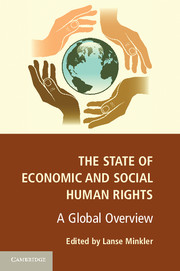Book contents
- Frontmatter
- Contents
- Contributors
- Acknowledgments
- 1 Introduction: Why Economic and Social Human Rights?
- I CORE RIGHTS
- II NONDISCRIMINATION
- III META
- 10 Establishing a Social and International Order for the Realization of Human Rights
- 11 Beyond a Minimum Threshold: The Right to Social Equality
- 12 The Right to Development from a Human Rights Approach: Conceptual Bases, Legal Framework, and Contemporary Challenges
- 13 Constitutional Environmental Human Rights: A Descriptive Analysis of 142 National Constitutions
- 14 Conclusion: Reflections on the Theory and Practice of Economic and Social Rights
- Index
- References
13 - Constitutional Environmental Human Rights: A Descriptive Analysis of 142 National Constitutions
Published online by Cambridge University Press: 05 February 2013
- Frontmatter
- Contents
- Contributors
- Acknowledgments
- 1 Introduction: Why Economic and Social Human Rights?
- I CORE RIGHTS
- II NONDISCRIMINATION
- III META
- 10 Establishing a Social and International Order for the Realization of Human Rights
- 11 Beyond a Minimum Threshold: The Right to Social Equality
- 12 The Right to Development from a Human Rights Approach: Conceptual Bases, Legal Framework, and Contemporary Challenges
- 13 Constitutional Environmental Human Rights: A Descriptive Analysis of 142 National Constitutions
- 14 Conclusion: Reflections on the Theory and Practice of Economic and Social Rights
- Index
- References
Summary
Introduction
Environmental human rights, succinctly defined as entitlements to clean air, water, and soil for present and future generations (Hiskes 2009), have both conceptual and legal foundations (Sax 1990). These rights fit within the basic rights framework outlined by Shue (1996), most notably subsistence rights. Without clean air, water, and soil, humans will be unable to enjoy other rights and life activities (Collins-Chobanian 2000). Because pollution does not respect geographic and, especially, temporal borders, environmental human rights necessitate a deeper concern for the rights of future generations. Recognizing these unique characteristics of environmental degradation, the first principle of The Stockholm Declaration of 1972 notes the responsibility humans have to protect the environment for both present and future generations. Although its signatories are not legally bound to uphold its principles, much of the language of the declaration forms the basis for modern binding and nonbinding instruments and declarations concerning the environment including, but not limited to, The African Charter of Human and People's Rights, the Brundtland Report, and the Ksentini Report (Hiskes 2011). Given these foundations, environmental human rights impose specific duties and obligations on governments, and have vast implications for government efforts to respect, protect, and fulfill said rights, including the nature of interference and definition of rights violations.
Governments seem to take these obligations seriously, as the world has seen a significant increase in the number of multinational and bilateral treaties and declarations concerned with recognizing a human right to a safe, healthy, or clean environment (Herz 2000; Hiskes 2011). This is also true for the human right to water (Scanlon, Cassar, and Nemes 1999). However, the question remains to what extent governments are trying to formalize and institutionalize these rights in national policy and law. Evidence of government effort can be found by looking closely at national constitutions, the topic of this chapter.
- Type
- Chapter
- Information
- The State of Economic and Social Human RightsA Global Overview, pp. 329 - 364Publisher: Cambridge University PressPrint publication year: 2013
References
- 6
- Cited by



